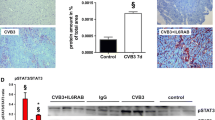Summary
T cell activation is assumed to play a crucial role in many viral infections. An important marker for the activation of T cells is the interleukin-2 receptor (IL-2R); resting T lymphocytes do not bear detectable amounts of IL-2R. AMT13, a rat monoclonal antibody against mouse IL-2R, inhibits interleukin-2-dependent cell growth both in vitro and in vivo. Therefore, to clarify the effects of anti-IL-2R antibody treatment upon coxsackievirus B3 (CB3)-infected C3H/He mice, AMT13, 1 µg/mouse per day, was administered, subcutaneously, starting on day 0 (group 2) in experiment I or on day 7 (group 4) in Experiment II for 7 days, respectively. Groups 1 and 3 were examined as infected controls. In both experiments, there was no significant difference in mortality or in the severity of myocarditis between the treated and the untreated groups. Also, myocardial CB3 titers on day 7 did not differ significantly between groups 1 and 2. In addition, the distribution of activated T cell subsets in the inflamed myocardium was not changed by the treatment, and the paucity of myocardial IL-2R-positive cells was confirmed in all groups. Effects of the antibody treatment were confirmed by a decrease in delayed type hypersensitivity. Although some reports have shown that anti-IL-2R antibody has been successfully applied to ameliorate acute renal graft-versus-host disease, to enhance survival of skin allografts, and to suppress diabetic insulitis, it did not exert a beneficial effect on acute CB3 myocarditis in mice.
Similar content being viewed by others
References
Blanden RV (1974) T cell response to viral and bacterial infection. Transplant Rev 19:56–60
Morgan DA, Rucetti FW, Gallo RC (1967) Selective in vitro growth of T lymphocytes from normal human bone marrow. Science 193:1007–1008
Waldmann TA (1986) The structure, function and expression of interleukin-2 receptors on normal and malignant lymphocytes. Science 232:727–732
Robb RJ, Munch A, Smith KA (1981) T cell growth factor receptors, quantitiation, specificity, and biological relevance. J Exp Med 154:1445–1474
Woodruff JF (1980) Viral myocarditis. A review. Am J Pathol 101:427–484
Reyes M, Lerner AM (1985) Coxsackievirus myocarditis. With special reference to acute and chronic effects. Prog Cardiovasc Dis 27:373–394
Abelmann WH (1973) Viral myocarditis and its sequelae. Annu Rev Med 24:145–152
Kishimoto C, Misaki T, Crumpacker CS, Abelmann WH (1988) Serial immunologic identification of lymphocyte subsets in murine coxsackievirus B3 myocarditis. Different kinetics and significance of lymphocyte subsets in the heart and in peripheral blood. Circulation 77:645–653
Kishimoto C, Abelmann WH (1990) In vivo significance of T cells in the development of coxsackievirus B3 myocarditis. Immature but antigen-specific T cells aggravate cardiac injury. Circ Res 67:589–598
Kishimoto C, Abelmann WH (1989) Monoclonal antibody therapy for prevention of acute coxsackievirus B3 myocarditis in mice. Circulation 79:1300–1308
Hancock WW, Lord RH, Colby AJ, Diamanstein T, Rickles FR, Dijkstra C, Hogg N, Tilney NL (1987) Identification of IL-2R+ cells and macrophages within rejecting rat cardiac allografts, and comparison of the effects of treatment with anti-IL-2R monoclonal antibody or cyclosporin. J Immunol 138:164–170
Granstein RD, Goulston C, Gaulton GN (1986) Prolongation of murine skin allograft survival by immunologic manipulation with anti-interleukin 2 receptor antibody. J Immunol 136:989–902
Kirkman RL, Barrett LV, Gaulton GN, Kelly VE, Koltun WA, Schoen FJ, Ythier A, Strom BT (1985) The effect of anti-interleukin-2 receptor monoclonal antibody on allograft rejection. Transplantation 40:719–722
Ueda H, Hancock WW, Cheung YC, Tanaka K, Kupiec-Weglinski JW, Tilney NL (1990) Differential effects of inteleukin-2 receptor targeted therapy on heart and kidney allografts in rats. Transplantation 49:1124–1129
Kirkman RL, Barrett LV, Gaulton GN, Kelly VE, Koltun WA, Strom BT (1985) Administration of an anti-interleukin-2 receptor monoclonal antibody prolongs cardiac allograft survival in mice. J Exp Med 162:358–362
Leist TP, Kohler M, Eppler M, Zinkernagel RM (1989) Effects of treatment with IL-2 receptor specific monoclonal antibody in mice. Inhibition of cytotoxic T cell responses but not of T helper cells. J Immunol 143:628–632
Osawa H, Diamanstein T (1984) A rat monoclonal antibody that binds specifically to mouse T lymphoblast and inhibits IL-2 receptor functions. A putative anti-IL-2 receptor antibody. J Immunol 132:2445–2450
Hsu SM, Jaffe ES (1985) Phenotypic expression of T lymphocytes in thymus and peripheral lymphoid tissues. Am J Pathol 121:69–78
Strauchen JA, Breakstone BA (1987) IL-2 receptor expression in human lymphoid lesions. Immunohistochemical study of 166 cases. Am J Pathol 126:506–512
Seko Y, Matsuda H, Kato K, Hashimoto Y, Yagita H, Okumura K, Yazaki Y (1993) Expression of intercellular adhesion molecule-1 in murine hearts with acute myocarditis caused by coxsackievirus B3. J Clin Invest 91:1327–1336
Takada H, Kishimoto C, Hiraoka Y (1995) Therapy with immunoglobulin suppressed myocarditis in a murine coxsackievirus B3 model. Antiviral and anti-inflammatory effects. Circulation 92:1604–1611
Kishimoto C, Kuroki Y, Hiraoka Y, Ochiai H, Kurokawa M, Sasayama S (1994) Cytokine and murine coxsackievirus B3 myocarditis. Interleukin-2 suppressed myocarditis in the acute stage but enhanced the condition in the subsequent stage. Circulation 89:2836–2842
Kishimoto C, Abelmann WH (1989) Absence of effects of cyclosporine on myocardial lymphocyte subsets in coxsackievirus B3 myocarditis in the aviremic stage. Circ Res 65:934–945
Estrin M, Huber SA (1987) Coxsackievirus B3 induced myocarditis. Autoimmunity is L3T4+ helper cell and IL-2 independent in Balb/c mice. Am J Pathol 127:335–341
Estrin M, Smith C, Huber SA (1986) Coxsackievirus B3 myocarditis. T-cell autoimmunity to heart antigens is resistant to cyclosporin-A treatment. Am J Pathol 125:244–251
Author information
Authors and Affiliations
Rights and permissions
About this article
Cite this article
Kishimoto, C., Hiraoka, Y., Takada, H. et al. Failure of treatment with interleukin-2 receptor-specific monoclonal antibody in acute coxsackievirus B3 myocarditis in mice. Heart Vessels 12, 221–228 (1997). https://doi.org/10.1007/BF02766787
Received:
Revised:
Accepted:
Issue Date:
DOI: https://doi.org/10.1007/BF02766787




